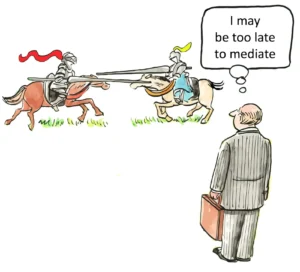How Courts Are Addressing AI-Driven Discrimination Cases
In recent years, the rapid advancement of artificial intelligence (AI) technologies has led to their widespread adoption across various industries, including employment, housing, and financial services. While AI systems promise increased efficiency and objectivity in decision-making processes, they have also raised significant concerns about potential discrimination and bias. As a result, courts are increasingly grappling with cases involving AI-driven discrimination, setting important precedents for how these complex issues will be addressed in the legal landscape.
The intersection of AI and anti-discrimination law presents novel challenges for the judiciary. Courts must navigate the intricate technical aspects of AI systems while applying longstanding legal principles to new contexts. This article examines how courts are approaching AI-driven discrimination cases, the legal frameworks being applied, and the implications for both AI developers and the individuals affected by these technologies.
Legal Framework for AI Discrimination Cases
The primary legal framework for addressing AI-driven discrimination cases in the United States stems from existing anti-discrimination laws. These include:
- Title VII of the Civil Rights Act of 1964: Prohibits employment discrimination based on race, color, religion, sex, and national origin.
- Age Discrimination in Employment Act (ADEA): Protects individuals 40 years of age or older from age-based discrimination in employment.
- Americans with Disabilities Act (ADA): Prohibits discrimination against individuals with disabilities in various areas of public life, including employment.
- Fair Housing Act (FHA): Prohibits discrimination in housing based on race, color, national origin, religion, sex, familial status, and disability.
- Equal Credit Opportunity Act (ECOA): Prohibits discrimination in lending based on race, color, religion, national origin, sex, marital status, age, or receipt of public assistance.
These laws were not originally designed with AI systems in mind, but courts are now tasked with applying them to cases involving algorithmic decision-making. The key legal theories being used to challenge AI-driven discrimination are disparate treatment and disparate impact.
Disparate Treatment
Disparate treatment refers to intentional discrimination based on a protected characteristic. In the context of AI, this could involve deliberately programming an algorithm to treat individuals differently based on their race, gender, or other protected attributes. While such overt discrimination is relatively rare in AI systems, courts have recognized that disparate treatment can also occur when a company knowingly uses an AI system that produces discriminatory results.
For example, in a recent case against a major social media platform, the Department of Justice alleged that the company’s ad targeting system allowed advertisers to explicitly exclude users based on protected characteristics. The court found that this constituted intentional discrimination, even though the discrimination was carried out by an automated system.
Disparate Impact
Disparate impact theory addresses practices that, while facially neutral, disproportionately affect members of protected groups. This theory is particularly relevant to AI-driven discrimination cases, as many AI systems produce biased outcomes without being explicitly programmed to discriminate.
Under disparate impact analysis, plaintiffs must typically show that a specific practice causes a statistically significant disparity in outcomes for a protected group. The burden then shifts to the defendant to demonstrate that the practice is job-related and consistent with business necessity. If the defendant meets this burden, the plaintiff can still prevail by showing that an alternative practice with less discriminatory impact could serve the defendant’s legitimate needs.
Courts are now grappling with how to apply this framework to complex AI systems. One key challenge is identifying the specific practice causing the disparity when dealing with “black box” machine learning algorithms. Additionally, courts must determine how to assess business necessity and less discriminatory alternatives in the context of AI-driven decision-making.
Recent Court Decisions on AI Discrimination
Several recent court decisions have begun to shape the legal landscape for AI-driven discrimination cases. These rulings provide insight into how courts are approaching the unique challenges posed by AI systems.
Mobley v. Workday, Inc.
One of the most significant recent cases is Mobley v. Workday, Inc., decided by the U.S. District Court for the Northern District of California in 2024. The plaintiff alleged that Workday’s AI-powered applicant screening tools discriminated against job applicants based on race, age, and disability.
In a groundbreaking decision, the court held that AI service providers like Workday could be directly liable for employment discrimination under an agency theory. The court reasoned that by developing and implementing AI tools that make or significantly influence hiring decisions, these providers are acting as agents of employers and can therefore be held accountable under anti-discrimination laws.
The court’s decision in Mobley is particularly noteworthy for several reasons:
- Expansion of Liability: By allowing claims against AI vendors, the court expanded the scope of potential liability for discriminatory hiring practices beyond traditional employers.
- Recognition of AI’s Role: The court acknowledged the significant role that AI systems play in modern hiring processes, refusing to draw an “artificial distinction between software decision-makers and human decision-makers.”
- Disparate Impact Analysis: The court allowed the plaintiff’s disparate impact claims to proceed, finding that the allegations of widespread rejections across numerous job applications were sufficient to infer a discriminatory effect at the pleading stage.
This ruling has significant implications for AI developers and companies using AI-powered hiring tools. It suggests that courts are willing to hold these entities accountable for discriminatory outcomes, even if the discrimination was not intentional.
EEOC v. iTutorGroup
Another important case is the Equal Employment Opportunity Commission’s (EEOC) lawsuit against iTutorGroup, which was settled in August 2023. This case marked the EEOC’s first lawsuit alleging employment discrimination through the use of AI.
The EEOC alleged that iTutorGroup, a tutoring services company, violated the Age Discrimination in Employment Act by programming its applicant screening software to automatically reject male applicants over 60 years old and female applicants over 55. The case highlighted the potential for AI systems to perpetuate explicit discriminatory policies.
Under the settlement, iTutorGroup agreed to pay $365,000 and implement significant changes to its hiring practices, including:
- Ceasing use of the discriminatory screening practices
- Retaining an AI bias expert to review its hiring practices
- Providing anti-discrimination training to employees involved in hiring decisions
- Implementing record-keeping and reporting requirements
This case demonstrates the EEOC’s willingness to pursue AI-driven discrimination cases and provides a blueprint for the types of remedies that may be required in such cases.
HUD v. Facebook
In 2019, the Department of Housing and Urban Development (HUD) filed a lawsuit against Facebook, alleging that the company’s ad targeting system allowed landlords and home sellers to discriminate against protected groups in violation of the Fair Housing Act.
While this case was ultimately settled, it raised important questions about how courts should apply anti-discrimination laws to complex AI-driven advertising systems. The lawsuit alleged that Facebook’s algorithm not only allowed advertisers to explicitly target ads based on protected characteristics but also used machine learning to infer protected characteristics and target ads accordingly.
The settlement required Facebook to make significant changes to its ad targeting system for housing, employment, and credit ads, including:
- Eliminating targeting options related to protected characteristics
- Creating a separate portal for housing, employment, and credit ads with limited targeting options
- Implementing a system to identify and block discriminatory ads
This case highlighted the potential for AI systems to perpetuate discrimination in subtle ways, even when not explicitly programmed to do so.
Challenges in Adjudicating AI Discrimination Cases
As courts continue to grapple with AI-driven discrimination cases, several key challenges have emerged:
Technical Complexity
One of the primary challenges courts face is understanding the technical aspects of AI systems. Many modern machine learning algorithms are highly complex and operate as “black boxes,” making it difficult to determine exactly how they arrive at their decisions. This complexity can make it challenging for courts to assess whether a particular AI system is truly causing discriminatory outcomes and, if so, how to remedy the issue.
To address this challenge, courts are increasingly relying on expert testimony from computer scientists, data scientists, and AI ethicists. However, there is ongoing debate about the best methods for auditing AI systems for bias and how to interpret the results of such audits.
Causation and Attribution
Another significant challenge is determining causation and attribution in AI discrimination cases. When an AI system produces discriminatory outcomes, it can be difficult to pinpoint the exact cause. The bias could stem from various sources, including:
- Biased training data: If the data used to train the AI system reflects historical discrimination, the system may learn to replicate those biases.
- Algorithmic design: The choices made in designing the algorithm, such as which features to include or how to weight different factors, can inadvertently lead to discriminatory outcomes.
- Implementation issues: Problems in how the AI system is deployed or integrated with other systems could contribute to discriminatory results.
Courts must grapple with how to attribute responsibility for these various potential sources of bias, especially when multiple parties may be involved in developing and implementing an AI system.
Balancing Innovation and Regulation
Courts also face the challenge of balancing the need to prevent discrimination with the desire to foster innovation in AI technology. Overly stringent regulations or liability rules could potentially stifle the development of beneficial AI systems. On the other hand, a lack of accountability could allow discriminatory practices to proliferate unchecked.
This balancing act is particularly evident in discussions around algorithmic transparency. While greater transparency could help identify and address discriminatory outcomes, it could also potentially expose proprietary information or trade secrets. Courts and policymakers are still working to find the right balance between these competing interests.
Emerging Legal Standards and Best Practices
As courts continue to address AI-driven discrimination cases, several legal standards and best practices are beginning to emerge:
Algorithmic Impact Assessments
Some jurisdictions are beginning to require algorithmic impact assessments (AIAs) for AI systems used in high-stakes decision-making. These assessments typically involve:
- Identifying potential risks and impacts of the AI system
- Assessing the system for potential biases
- Developing mitigation strategies for identified risks
- Ongoing monitoring and evaluation of the system’s performance
While the specific requirements for AIAs vary, they generally aim to promote transparency and accountability in AI development and deployment.
Explainable AI
There is growing emphasis on the development of explainable AI systems, which can provide insight into how they reach their decisions. This approach can make it easier for courts to assess whether an AI system is operating in a discriminatory manner and to identify the source of any bias.
Explainable AI techniques include:
- Feature importance analysis: Identifying which input features have the most significant impact on the AI’s decisions.
- Counterfactual explanations: Demonstrating how changing specific inputs would alter the AI’s output.
- Rule extraction: Deriving human-interpretable rules that approximate the AI’s decision-making process.
While fully explainable AI systems may not always be feasible, courts are likely to look favorably on efforts to increase transparency and interpretability.
Ongoing Monitoring and Auditing
Courts are increasingly emphasizing the importance of ongoing monitoring and auditing of AI systems for potential bias. This may involve:
- Regular testing of the system’s outputs for disparate impact
- Comparing the system’s performance across different demographic groups
- Analyzing feedback and complaints from affected individuals
- Periodic third-party audits of the system
Companies using AI systems for high-stakes decisions may need to demonstrate that they have robust monitoring and auditing processes in place to detect and address potential discrimination.
Human Oversight and Intervention
While AI systems can process vast amounts of data and make rapid decisions, courts are likely to require meaningful human oversight, especially in high-stakes contexts. This may involve:
- Human review of AI-generated decisions before they are finalized
- Clear processes for individuals to appeal or challenge AI-driven decisions
- Regular human evaluation of the AI system’s overall performance and impact
The level of human oversight required may vary depending on the context and potential impact of the AI system’s decisions.
Implications for AI Developers and Users
The evolving legal landscape surrounding AI-driven discrimination has significant implications for both AI developers and companies using AI systems:
Increased Liability Risk
The Mobley v. Workday decision suggests that AI developers may face direct liability for discriminatory outcomes produced by their systems, even when they are not the ultimate decision-makers. This expanded liability risk means that AI companies will need to be much more proactive in addressing potential bias in their systems.
Enhanced Due Diligence
Companies using AI systems for high-stakes decisions will need to conduct thorough due diligence on these systems, including:
- Assessing the potential for bias in the system’s training data and algorithms
- Evaluating the system’s performance across different demographic groups
- Implementing robust monitoring and auditing processes
- Ensuring clear processes for human oversight and intervention
Failure to conduct adequate due diligence could potentially expose companies to significant legal risk.
Documentation and Record-Keeping
Given the complex nature of AI systems, thorough documentation and record-keeping will be crucial for defending against discrimination claims. This may include:
- Detailed records of the AI system’s development process
- Documentation of data sources and preprocessing steps
- Records of testing and validation procedures
- Logs of the system’s decisions and their rationales
- Documentation of any identified biases and mitigation efforts
Courts are likely to look unfavorably on companies that cannot provide clear documentation of their AI systems’ development and operation.
Collaboration with Legal and Compliance Teams
AI developers and users will need to work closely with legal and compliance teams to ensure that their systems comply with anti-discrimination laws. This may involve:
- Incorporating legal and ethical considerations into the AI development process
- Conducting regular legal reviews of AI systems and their outputs
- Developing clear policies and procedures for addressing potential discrimination
- Providing training to employees on the legal and ethical implications of AI use
Early and ongoing collaboration between technical and legal teams will be crucial for mitigating legal risks associated with AI systems.
Future Directions in AI Discrimination Law
As AI technology continues to evolve and its use becomes more widespread, we can expect further developments in how courts address AI-driven discrimination cases. Some potential future directions include:
Specialized AI Courts or Tribunals
Given the technical complexity of AI discrimination cases, some jurisdictions may consider establishing specialized courts or tribunals with expertise in both law and technology. These bodies could be better equipped to handle the unique challenges posed by AI-driven discrimination cases.
AI-Specific Legislation
While courts are currently applying existing anti-discrimination laws to AI cases, there may be a push for AI-specific legislation that directly addresses the unique issues raised by algorithmic decision-making. Such legislation could provide clearer guidelines for AI developers and users on how to avoid discriminatory outcomes.
International Cooperation and Standards
As AI systems often operate across national borders, there may be efforts to develop international standards and cooperation mechanisms for addressing AI-driven discrimination. This could help ensure more consistent treatment of these issues across different jurisdictions.
Evolving Standards of Evidence
Courts may need to develop new standards for what constitutes sufficient evidence of discrimination in AI cases. This could involve new statistical tests or benchmarks for assessing algorithmic bias, as well as guidelines for how to interpret complex AI audit results.
Expanded Role for Regulatory Agencies
Regulatory agencies like the EEOC, HUD, and FTC may take on a more active role in addressing AI-driven discrimination. This could involve issuing more detailed guidance, conducting proactive investigations, and potentially even certifying or approving certain AI systems for use in high-stakes decision-making.
Conclusion
As courts continue to grapple with AI-driven discrimination cases, they are laying the groundwork for how these complex issues will be addressed in the coming years. The legal landscape is still evolving, but several key trends are emerging:
- Courts are willing to hold AI developers and users accountable for discriminatory outcomes, even when the discrimination is not intentional.
- There is increasing emphasis on transparency, explainability, and ongoing monitoring of AI systems.
- Human oversight and intervention remain crucial, especially in high-stakes decision-making contexts.
- Companies using AI systems face heightened due diligence and documentation requirements.
As AI technology continues to advance and its use becomes more widespread, we can expect further refinement of legal standards and best practices for addressing AI-driven discrimination. Both AI developers and users will need to stay abreast of these developments to ensure compliance with anti-discrimination laws and mitigate legal risks.
Ultimately, the goal is to harness the potential of AI to improve decision-making while ensuring that these systems do not perpetuate or exacerbate existing patterns of discrimination. By carefully navigating the legal and ethical challenges posed by AI, we can work towards a future where these powerful technologies promote fairness and equality rather than undermine them.
Sources:
- https://www.seyfarth.com/news-insights/mobley-v-workday-court-holds-ai-service-providers-could-be-directly-liable-for-employment-discrimination-under-agent-theory.html
- https://www.thesandersfirmpc.com/legal-commentary-ai-hiring-discrimination-and-workday-lawsuit
- https://www.clarkhill.com/news-events/news/artificial-discrimination-ai-vendors-may-be-liable-for-hiring-bias-in-their-tools/
- https://www.laborandemploymentlawinsights.com/2024/08/california-court-finds-that-




















